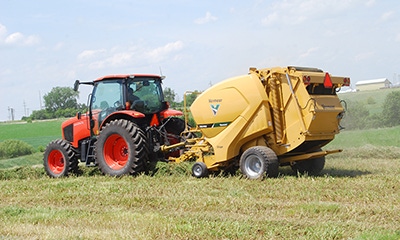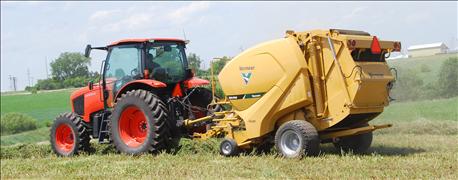October 1, 2015

This time of year there are always questions on when that last cutting of hay could be made and still allow enough time to build root carbohydrate reserves in the plant before the first killing frost hits. The answers to these questions are usually something like… "it is fine to harvest through the first week of September", and… "we recommend harvesting at least six weeks before the killing frost." On average, the alfalfa killing frost (24 to 25 degrees F) in northeast Iowa occurs in the third to fourth week of October.

TIMING THE FINAL CUT: Allow enough time between when you make the final cutting of alfalfa in the fall and when the first killing frost occurs. That gives the plants enough time to recover and build nutrient reserves in the roots to survive winter.
While those "good old answers" still work, the more correct answer actually deals with growing degree days (GDD), not the calendar, says Brian Lang, an Iowa State University Extension field agronomist at Decorah in northeast Iowa. "Researchers now define a risk assessment of fall harvest based on alfalfa GDD's," says Lang. "The research basically says as long as the plants accumulate at least 500 GDD from harvest to killing frost, the plants will have stored enough root carbohydrate to survive the winter."
Harvesting alfalfa in late September or in October is higher risk
A nice summary of this research is available at the following website, says Lang. The data from Lancaster and Beloit, Wis. (southern Wisconsin) would apply quite nicely to northeast Iowa. The website is uwex.edu/ces/forage/pubs/Late-Summer-Cutting-Management-of-Alfalfa.pdf.
The Lancaster and Beloit data suggest alfalfa harvested through the first week of September is very low risk of winter injury, having plenty of time to replenish root carbohydrates going into the winter. A September 15 harvest could start providing some risk, and a September 21 harvest will provide even more risk. "These risks do not mean that you will lose the entire stand, but rather would likely lose a percentage of plants and reduction in first crop yield next season because of winter injury and slowed plant recovery in spring," Lang explains.
~~~PAGE_BREAK_HERE~~~
What's the risk of cutting alfalfa after the first killing frost?
What if you chose to harvest "after the killing frost"? This research says as long as the plants do not accumulate more than 200 GDD from after harvest to before the killing frost hits, the alfalfa plants should still overwinter just fine, says Lang. This means you do not have to wait for the actual killing frost to occur as long as you are close enough to it when you harvest.
For example, October 15 is a good cut-off date where if the killing frost has not occurred yet, it likely will soon, and the weather in late October is usually cold enough that 200 GDD will not accumulate within the time remaining in the fall. "A critical issue with harvesting after a killing frost is that little to no regrowth will occur following the harvest, so you want to cut the alfalfa high leaving about a 6-inch stubble height to help trap snow and insulate the plants," says Lang.
Frost & alfalfa, clovers and other bloat potential forages
In hay fields, 24 degrees F is often considered a killing frost. In pastures with plant growth of a shorter stature relative to a hay crop (closer proximity to radiant heat from the soil) may require a colder temperature. But even 26 degrees F will cause some frost damage. In either case, when alfalfa and clovers are frosted, they have a short-term risk of a higher bloat potential, and this threat is elevated if that early morning forage also has a heavy dew. For an explanation of this and suggested management, please read the article below.
"Alfalfa is not Bloat Safe After a Killing Frost" by Dennis Cosgrove - UW River Falls, Peter Jeranyama – South Dakota State University, Dwain Meyer –North Dakota State University, Paul Peterson—University of Minnesota, and Dan Undersander—University of Wisconsin-Madison.
Average occurrence of the first 32-degree F, 28-degree F and 24-degree F fall frost in northeast Iowa
Location (N to S) | 32F, light frost | 28F, corn/soybean killing frost | 24F, alfalfa killing frost |
Cresco | Oct. 5 | Oct. 13 |
|
Decorah | Sept. 30 | Oct. 9 | Oct. 19 |
Waukon | Oct. 8 | Oct. 19 |
|
New Hampton | Oct. 5 | Oct. 15 |
|
Fayette | Sept. 26 | Oct. 5 |
|
Tripoli | Oct. 7 | Oct. 16 |
|
Oelwein | Sept. 30 | Oct. 9 |
|
Independence | Oct. 1 | Oct. 12 | Oct. 26 |
Manchester | Oct. 3 | Oct. 10 |
|
Cascade | Sept. 30 | Oct. 11 |
|
You May Also Like




